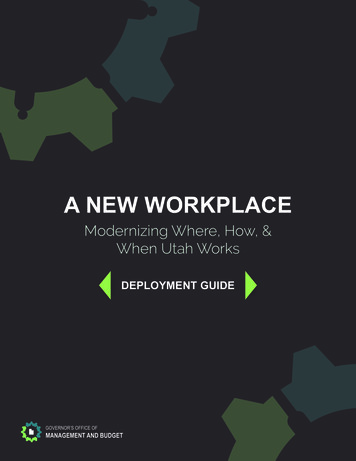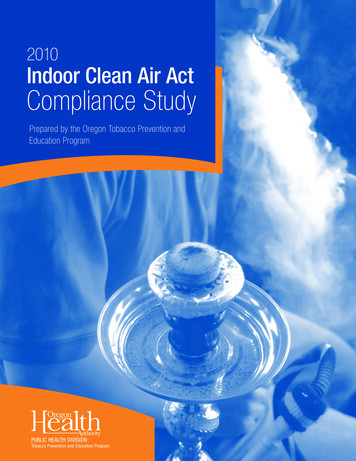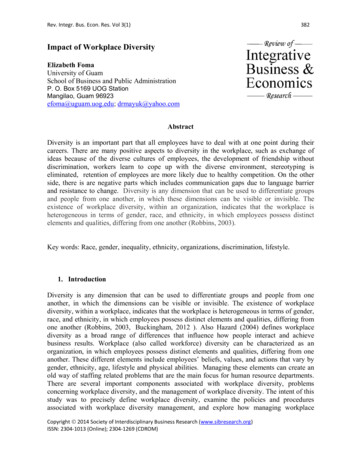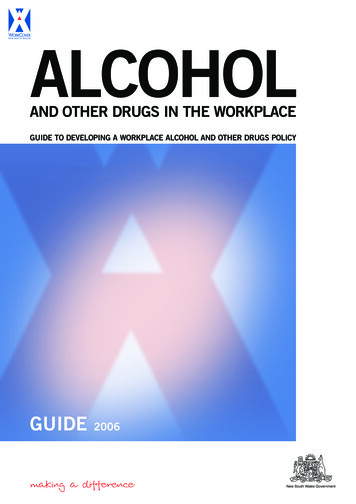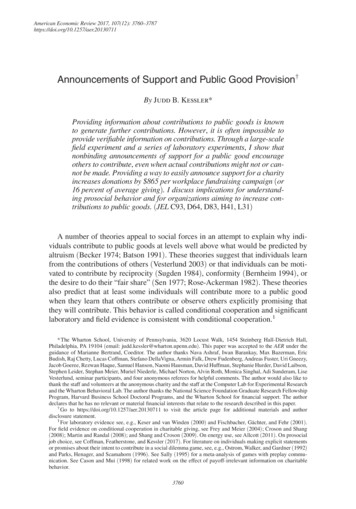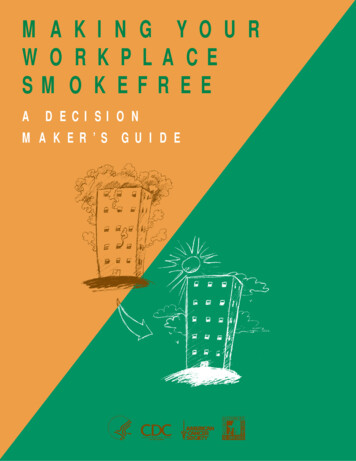
Transcription
M A K I N G Y O U RW O R K P L A C ES M O K E F R E EAD E C I S I O NM A K E R ’ SG U I D E
M A K I N G Y O U RW O R K P L A C ES M O K E F R E EAD E C I S I O NM A K E R ’ SG U I D EU.S. Department of Health and Human ServicesCenters for Disease Control and PreventionOffice on Smoking and HealthWellness Councils of AmericaAmerican Cancer Society
PREFACEAs scientific evidence documenting the health hazards posed by environmental tobaccosmoke (ETS) continues to mount, workplace decision makers have more reason thanever to protect employees from exposure to ETS on the job. The U.S. EnvironmentalProtection Agency concluded in January 1993 that each year ETS kills an estimated3,000 adult nonsmokers from lung cancer and that the workplace is a significantsource of ETS. In a recent study, nonsmoking employees exposed to ETS at work butnot at home had significantly higher levels of a nicotine metabolite in their blood thandid nonsmoking workers with no work or home exposure to ETS. Levels of exposure toETS are lowest in smokefree workplaces.Even before these recent studies were available, the U.S. Surgeon General had determined in 1986 that ETS is a cause of disease, including lung cancer, in otherwisehealthy nonsmokers. The Surgeon General also reported that the simple separation ofsmokers and nonsmokers within the same airspace may reduce, but does not eliminate,the exposure of nonsmokers to ETS. In 1991, the National Institute of OccupationalSafety and Health of the Centers for Disease Control and Prevention recommended that“all available preventive measures should be used to minimize occupational exposureto ETS.”Health issues provide ample justification for restricting ETS exposure at the worksite.But there are other good business reasons. Instituting smokefree work environmentscan reduce costs for cleaning and maintaining facilities and equipment and improveemployee morale. “Smokefree” does not mean “anti-smoker.” Policies that restrict oreliminate smoking may provide incentives for employees to stop smoking altogether.You can demonstrate your commitment to employees who smoke by offering to helpinterested smokers quit.In brief, that’s the “why” for companies and organizations to go smokefree. This handbook, Making Your Workplace Smokefree: A Decision Maker’s Guide, provides the “how.”This up-to-date guide draws on years of research and first-hand experience, and itoffers practical and proven strategies for implementing successful policies in a varietyof work settings. As you will see in this guide, with a little planning an effective workplace policy is easy to implement. We hope that workplace decision makers will usethis handbook as a blueprint for action in promoting the health and safety of allworkers.Michael P. Eriksen, ScDDirector, Office on Smoking and HealthNational Center for Chronic Disease Prevention and Health PromotionCenters for Disease Control and PreventionPrefacei
TABLE OF CONTENTSPREFACE . . . . . . . . . . . . . . . . . . . . . . . . . . . . . . . . . . . . . . . . . . . . . . . . . . . . . . .iACKNOWLEDGMENTS . . . . . . . . . . . . . . . . . . . . . . . . . . . . . . . . . . . . . . . . . . .iiABOUT THIS GUIDE . . . . . . . . . . . . . . . . . . . . . . . . . . . . . . . . . . . . . . . . . . . . .viCHAPTER ONE. COSTS AND OTHER CONSEQUENCES OF TOBACCO . . . . . . . .1Adverse Effects of Combining Cigarette Smoking and OtherWorkplace Risks . . . . . . . . . . . . . . . . . . . . . . . . . . . . . . . . . . . . . . . . . . . .2Health Consequences of ETS . . . . . . . . . . . . . . . . . . . . . . . . . . . . . . . . . . . .3Costs to Employers . . . . . . . . . . . . . . . . . . . . . . . . . . . . . . . . . . . . . . . . . . . .4Liability . . . . . . . . . . . . . . . . . . . . . . . . . . . . . . . . . . . . . . . . . . . . . . . . . . . .5Costs to Individuals and to Society . . . . . . . . . . . . . . . . . . . . . . . . . . . . . . .6CHAPTER TWO. BENEFITS OF A SMOKEFREE WORKPLACE . . . . . . . . . . . . . .11Support for Workplace Policies . . . . . . . . . . . . . . . . . . . . . . . . . . . . . . . . . .12Employee Morale . . . . . . . . . . . . . . . . . . . . . . . . . . . . . . . . . . . . . . . . . . . .12Productivity and Medical Costs . . . . . . . . . . . . . . . . . . . . . . . . . . . . . . . . .13Corporate Image . . . . . . . . . . . . . . . . . . . . . . . . . . . . . . . . . . . . . . . . . . . .13CHAPTER THREE. A DECISION MAKER’S GUIDE TO CHOOSINGA WORKPLACE POLICY . . . . . . . . . . . . . . . . . . . . . . . . . . . . . . . . . . . . . . . . . .17It’s Your Decision . . . . . . . . . . . . . . . . . . . . . . . . . . . . . . . . . . . . . . . . . . . .18Model Smokefree Policy and Procedure . . . . . . . . . . . . . . . . . . . . . . . . . . .19CHAPTER FOUR. SUPPORT FOR EMPLOYEES WHO SMOKE . . . . . . . . . . . . . . .23The Goal: A Smokefree Workplace, Not Stigmatizing EmployeesWho Smoke . . . . . . . . . . . . . . . . . . . . . . . . . . . . . . . . . . . . . . . . . . . . . .24Nicotine Addiction . . . . . . . . . . . . . . . . . . . . . . . . . . . . . . . . . . . . . . . . . . .24Immediate Benefits of Quitting Smoking . . . . . . . . . . . . . . . . . . . . . . . . . .25Smoking Cessation and the Workplace . . . . . . . . . . . . . . . . . . . . . . . . . . .25Types of Support for Employees Who Smoke . . . . . . . . . . . . . . . . . . . . . . .26Match Support to Employee Needs . . . . . . . . . . . . . . . . . . . . . . . . . . . . . . .26Cessation Support Options . . . . . . . . . . . . . . . . . . . . . . . . . . . . . . . . . . . . .28Deciding What Types of Support to Offer . . . . . . . . . . . . . . . . . . . . . . . . . .31iv
CHAPTER FIVE. STEP-BY-STEP: YOUR DECISIONS AND HOW TOMAKE THEM WORK. . . . . . . . . . . . . . . . . . . . . . . . . . . . . . . . . . . . . . . . . . . .33Assess the Current Situation . . . . . . . . . . . . . . . . . . . . . . . . . . . . . . . . . . . .34Decide on a New ETS Policy and Develop a Plan to Implement It . . . . . . .37Communicate with Employees and Management . . . . . . . . . . . . . . . . . . .38Announce and Manage the Policy . . . . . . . . . . . . . . . . . . . . . . . . . . . . . . .39APPENDICES . . . . . . . . . . . . . . . . . . . . . . . . . . . . . . . . . . . . . . . . . . . . . . . . . .43Appendix A. Resources . . . . . . . . . . . . . . . . . . . . . . . . . . . . . . . . . . . . . . .44Appendix B. Sample Policies . . . . . . . . . . . . . . . . . . . . . . . . . . . . . . . . . . .46Appendix C. Organizations with Smokefree Workplaces . . . . . . . . . . . . . .49Table Of Contentsv
ABOUT THIS GUIDEGOAL: Provide a 100% smokefree workplace environment. Protect all employees from exposure to environmental tobacco smoke. Provide cessation support to smokers who want to quit smoking.This guide provides you, the worksite decision maker, with information on how todesign, implement, and evaluate environmental tobacco smoke (ETS) policies andrelated activities. Ideally, to protect all persons from exposure to ETS, companies willimplement policies that require a smokefree environment in company buildings andother enclosed places and provide significant smoking cessation support for theiremployees and covered dependents.Chapter One provides the background information you need to make the decision toimplement policies and related activities to eliminate ETS in the workplace.Chapter Two highlights legal, scientific, human resource, facility, image, and economic reasons to reduce ETS in the workplace.Chapter Three provides a model smoking policy and additional options to help companies and other organizations design policies to fit their needs.Chapter Four helps the company develop smoking cessation activities to ensure helpis available for employees who want to quit smoking.Chapter Five provides step-by-step instructions in designing policies and related programs to meet the needs of the company.Additional resources, sample policies, and a list of organizations with smokefreeworkplaces are included in the Appendices.vi
Chapter1C O S T SA N DO T H E RC O N S E Q U E N C E SO FT O B A C C O
Tobacco causes more deaths than AIDS, alcoholabuse, automobile accidents, illegal drugs, fires,homicide, and suicide combined.1Adverse Effects ofCombining CigaretteSmoking and OtherWorkplace RisksExamples of hazardous materialsthat when com-According to the 1985 Surgeon General’sbined withreport on The Health Consequences ofsmoking present aSmoking: Cancer and Chronic Lung Diseaseserious healthin the Workplace, the combination ofrisk :smoking with exposure to hazardous5 Coalsubstances at the workplace presents a Grain Silica WeldingmaterialsCigarette smoking is the leadingpreventable cause of death inthis country: it is responsible for one in Asbestosevery five American deaths.2 Smoking Petrochemicalsclaims the lives of an estimated 1,100 Aromatic amines Pesticides Cotton dust Ionizingradiationserious health risk.5 As explained in the1979 Surgeon General’s report on smoking and health, cigarette smoking can transform existing chemicals intomore harmful ones,people each day—over 400,000 smokersdie from smoking-related diseases and 3,000 nonsmokers die from lung cancerincrease exposure to existing toxicchemicals,each year.2,3 In addition, nonsmokersexposed to environmental tobacco smoke (ETS) have higher death ratesadd to the biological effects caused bycertain chemicals, andfrom cardiovascular disease than nonsmokers who are not exposed to ETS.4Asbestos workersSince the first Surgeon General’s reportten times the riskon smoking and health in 1964, tobaccoof developinguse has been increasingly linked to dis-lung cancer asease, disability, and premature death.who do notsmoke.5That is, tobacco users die sooner thanpeople who don’t use tobacco. Figure1-1 lists known effects of tobacco use andETS.2interact synergistically with existingchemicals.6who smoke haveasbestos workers Chapter 1For example, the health effects of smoking and workplace exposure to asbestosare greater than the sum of the risks ofseparate exposures. For most workerswho smoke, however, cigarette smokingis a greater cause of death and disabilitythan any hazard in the workplace.5
HealthFIGURE 1-1. HEALTH CONSEQUENCES OF TOBACCOUSE AND ETSConsequences of ETSETS is a proven health hazard. Forexample, the 1986 Surgeon General’sreport on involuntary smoking concluded that exposure to ETS can cause lungcancer: nonsmoking spouses have nearly a doubled risk of developing lungcancer if their spouses are heavy smokers.7 Research reviewed in the reports ofthe Surgeon General, the NationalAcademy of Sciences,8 and the NationalInstitute of Occupational Safety andHealth (NIOSH)9 found that secondhandtobacco smoke was harmful, and theU.S. Environmental Protection Agency(EPA)3 estimated that ETS causes 3,000lung cancer deaths each year in theUnited States. In addition, scientificstudies published in peer-reviewed journals on both animals and human subjects indicate that nonsmokers exposedto secondhand tobacco smoke havehigher death rates from heart disease.4,10–12 Figure 1-2 highlights statements from important reports on ETS.ETS has been classified as a Group A(known human) carcinogen, as haveasbestos and benzene.3 Nonsmokerssubjected to ETS are exposed to nicotine,carbon monoxide, and cancer-causingagents. A recent study found that nonsmokers exposed to ETS only at workhad significantly higher levels of aHealth Consequences of Tobacco Use14–17Mortality and Morbidity Results in premature death Causes significant disease and disabilityCardiovascular Effects A cause of coronary heart disease A cause of cerebrovascular disease (stroke) A cause of atherosclerotic peripheral vascular diseaseCancer A cause of lung cancer A contributing factor for pancreatic cancer A cause of laryngeal cancer A contributing factor for renal cancer A cause of cancer of the oral cavity (lip, tongue, mouth, and pharynx);smokeless tobacco is also a cause of oral cancer Associated with gastric cancer A cause of esophageal cancer A cause of bladder cancerLung Diseases A cause of chronic bronchitis A cause of emphysemaWomen’s Health Effects A cause of intrauterine growth retardation, leading to low birth weightbabies A contributing factor for cervical cancer A probable cause of unsuccessful pregnanciesOther Health Effects Addiction to nicotine Adverse interactions with occupational hazards that increase the risk ofcancer Alteration of the actions and effects of prescription and nonprescriptionmedications A probable cause of peptic ulcer diseaseHealth Consequences of ETS3, 4, 7, 10–12, 18–20 A cause of lung cancer in nonsmokers Associated with higher death rates from cardiovascular disease in nonsmokers In children, associated with respiratory tract infections, increased prevalence of fluid in the middle ear, additional episodes of asthma, andincreased severity of symptoms in children with asthma, and a risk factorfor new onset of asthma in children who have not previously displayedsymptoms Associated with increased risk of sudden infant death syndrome (SIDS) Associated with increased irritant effects, particularly eye irritation,among allergic personsCosts And Other Consequences Of Tobacco3
FIGURE 1-2. STATEMENTS FROM REPORTS ON ETSCosts to EmployersIn 1986, the Surgeon General made these conclusions7:The costs of employee smoking to the Involuntary smoking is a cause of disease, including lung cancer, inhealthy nonsmokers. Simple separation of smokers and nonsmokers within the same airspacemay reduce but does not eliminate exposure of nonsmokers to ETS.In 1991, NIOSH strengthened the findings on ETS in theworkplace9: ETS is a potential occupational carcinogen. ETS poses an increased risk of lung cancer and possibly heart disease tooccupationally exposed workers. Exposure to ETS should be reduced to the lowest feasible level. Employers should minimize occupational exposure to ETS by using allavailable preventive measures.In 1993, the EPA released a report on the respiratory healtheffects associated with passive smoking with this conclusion3:employer are significant. Direct costs tothe employer include health care costsassociated with smoking. Indirect costsinclude lost productivity, absenteeism,and recruitment and retraining costsresulting from death and disability related to smoking. Following is a list ofsome of the factors that contribute tosmokers costing employers more thannonsmokers.21 Absenteeism Health insurance and life insurance ETS is a human lung carcinogen responsible for 3,000 lung cancer deathsannually in U.S. nonsmokers.Evidence that ETS is a risk factor for cardiovascular disease andother diseases continues to accumulate.3,4,10–12,18–20nicotine metabolite in their blood thancosts and claims and occupational health awards exposure.13combination of smoke exhaled bythe smoker andasthma have their condition worsenedcomes from theby exposure to ETS.3 Yet children oftenburning end of aspend considerable amounts of time incigarette, cigar, orthe worksites of adults (e.g., schools,pipe.restaurants).More people die from ETS than all otherregulated occupational substances combined.3 Even one of these deaths due toETS is unnecessary.4Chapter 1Property damage (plus related insurance costs)The EPA concluded that children withthe smoke thatAccidents and fires (plus relatedinsurance costs)nonsmokers reporting no workplaceETS is aWorker’s compensation payments Smoke pollution (increased cleaningand maintenance costs) Illness and discomfort among nonsmokers exposed to passive smokeThe cost to employers of employees whosmoke is not a simple number; manyfactors and variables need to be consid-
ered. However, the most frequently citedair quality, including ETS. In work-estimate for the excess cost (adjusted toplaces where smoking is not prohibited,1991 dollars) is 1,300 per year perthe proposed rule calls for designatedsmoking employee.21smoking areas that are enclosed andexhausted directly to the outside. TheOther costs arise from ETS. Historically,regulations have not been finalized as ofsmoking restrictions were implementedSeptember 1996. Many states andto prevent fires and explosions in themunicipalities have enacted legislationworkplace. These rules were establishedrestricting smoking in public, and someto protect products, machinery, and fur-have moved to restrict smoking at theniture rather than to protect the healthworksite. As of June 1995, 47 states hadof employees. Today, employers whorestricted smoking at some level in work-implement smokefree policies for theirplaces or public places, and 21 statesoffices can save money for the same rea-regulated smoking in private worksites.24son because computer equipment, furni-More than 800 local ordinances existture, and carpets last longer in a smoke-that impose restrictions on tobaccofree environment and require less main-use.25tenance.22Because no one has the right to imposeRegardless of the size of your company,a health risk on others and because animplementing smokefree policies andemployer has a common-law responsi-providing support to help employeesbility to provide a safe and healthfuland covered dependents to quit smokingworkplace,26 liability is a significantmakes good business sense.issue for employers. Because ETS hasETS containsbeen classified as a Group A (knownabout 4,000human) carcinogen, it would be difficultchemicalLiabilityAs early as 1972, the Surgeon Generalwarned that cigarette smoking was dangerous to nonsmokers.23 Since then,court rulings and state, county, and citystatutes and regulations have providedprotection for the nonsmoker. In March1994, the Occupational Safety andHealth Administration of the U.S.Department of Labor issued proposednational regulations to govern indoorto argue that an employer who has notreduced ETS to the lowest possible levelshas provided a safe workplace.compounds,includingformaldehyde,cyanide, carbonmonoxide,Recent examples show the validity ofammonia,liability concerns. In December of 1995,nicotine, anda widower of a Veterans Affairs hospitalcancer-causingnurse was awarded death benefits onagents such asthe grounds that his wife’s fatal lungbenzene andcancer was caused by exposure toN-nitrosamines.3secondhand smoke while treatingCosts And Other Consequences Of Tobacco5
FIGURE 1-3. ONE-YEAR COSTS OF SMOKING-ATTRIBUTABLEMEDICAL CARE (1993)31Type of CostHospital expendituresPhysician expendituresNursing home expendituresPrescription drugsHome health care expendituresTotalAmount ( billion)26.915.54.91.80.950.0 have higher outpatient health carecosts,29,30 and have lower birth weight babies.16A 1994 report from the Centers forDisease Control and Prevention (CDC)estimated that the cost of smoking fordirect medical care was 50 billion forpatients.27 In January 1996, a Florida1993 (Figure 1-3).31 Indirect costs ofstate appeals court ruled that airlinesmoking to society, such as lost produc-the workplaceflight attendants could proceed with ativity from increased absenteeism andand decreasingnational class-action lawsuit againstproductive years of lives lost, also aresmoking bycigarette manufacturers for their respon-enormous. For 1990, the Congressionalemployees cansibility in causing health problems relat-Office of Technology Assessment esti-reduce healthed to exposure to secondhand smoke.28mated that indirect costs from smoking-Eliminating ETS incare costs andattributable illness and death totaledincrease years of 47.2 billion.32productive life.These twofactors alone willCosts to Individualsand to SocietyETS is dangerous to employees and costly for employers. To protect all employ-positively affectthe bottom lineThe cost savings associated with a heartees from the health hazards associatedfor companies.attack that is prevented or with thewith ETS exposure, companies shouldWhile prematuredelayed onset of cancer are often diffi-restrict smoking in the workplace. Indeath amongcult to calculate. Yet, reducing theaddition, companies should offer assis-prevalence of smoking behavior in atance to employees and dependentsworksite can save money, not only forinterested in stopping smoking.smokers mayoffset theincreased healthcare costs withsavings in pensionthe employer but also for individualsand society as a whole. Individual costsbenefits, allin time, health, and money ariseresponsiblebecause smokers tend toquences of tobacco use and ETS expo-employers wanttheir employees have more hospital admissions,before and during take longer to recover from illnessand injury,retirement.6sure. Chapter Two discusses the benefitsof a smokefree workplace.to live full andproductive lives,This chapter has described the conse-Chapter 1
References1. McGinnis JM, Foege WH. Actualcauses of death in the United States.Journal of the American MedicalAssociation 1993;270:2207–2212.2. Centers for Disease Control andPrevention. Cigarette-attributablemortality and years of potential lifelost—United States, 1990. Morbidityand Mortality Weekly Report1993;42:645–649.3. U.S. Environmental ProtectionAgency. Respiratory health effects ofpassive smoking: Lung cancer andother disorders. The report of theEnvironmental Protection Agency. U.S.Environmental Protection Agency,Office of Research and Development,1993. (EPA/600/6-90/006F)4. Steenland K, Thun M, Lally C, HeathC. Environmental tobacco smokeand coronary heart disease in theAmerican Cancer Society CPS-IIcohort. Circulation 1996;94:622–628.5. U.S. Department of Health andHuman Services. The health consequences of smoking: Cancer and chronic lung disease in the workplace. Areport of the Surgeon General. U.S.Department of Health and HumanServices, Public Health Service, Officeon Smoking and Health, 1985.(DHHS Publication No. (PHS) 8550207)6. U.S. Department of Health,Education, and Welfare. Smoking andhealth. A report of the Surgeon General.U.S. Department of Health,Education, and Welfare, PublicHealth Service, Office on Smokingand Health, 1979. (DHEWPublication No. (PHS) 79-50066)7. U.S. Department of Health andHuman Services. The health consequences of involuntary smoking: Areport of the Surgeon General. U.S.Department of Health and HumanServices, Public Health Service,Centers for Disease Control, Office onSmoking and Health, 1986. (DHHSPublication No. (CDC) 87-8398).8. National Research Council.Environmental tobacco smoke:Measuring exposures and assessinghealth effects. Washington, DC:National Academy Press, 1986.9. U.S. Department of Health andHuman Services. NIOSH CurrentIntelligence Bulletin 54: Environmentaltobacco smoke in the workplace, lungcancer and other health effects. U.S.Department of Health and HumanServices, Public Health Service,Centers for Disease Control andPrevention, National Institute forOccupational Safety and Health,1991. (DHHS Publication No.(NIOSH) 91-108)10. Steenland K. Passive smoking andthe risk of heart disease. Journal ofthe American Medical Association1992;267:94–99.Costs And Other Consequences Of Tobacco7
11. Glantz SA, Parmley WW. Passivesmoking and heart disease:Epidemiology, physiology, and biochemistry. Circulation 1991;83:1–12.12. Taylor AE, Johnson DC, Kazemi H.Environmental tobacco smoke andcardiovascular health. A positionpaper from the Council onCardiopulmonary and Critical Care,American Heart Association.Circulation 1992;86:699–702.13. Pirkle JL, Flegal KM, Bernert JT, et al.Exposure of the US population toenvironmental tobacco smoke: Thethird National Health and NutritionExamination Survey, 1988–1991.Journal of the American MedicalAssociation 1996;275:1233–1240.14. U.S. Department of Health andHuman Services. The health consequences of smoking: Nicotine addiction. A report of the Surgeon General.U.S. Department of Health andHuman Services, Public HealthService, Centers for Disease Control,Office on Smoking and Health, 1988.15. U.S. Department of Health andHuman Services. Reducing the healthconsequences of smoking: 25 years ofprogress. A report of the SurgeonGeneral. U.S. Department of Healthand Human Services, Public HealthService, Centers for Disease Control,Office on Smoking and Health, 1989.(DHHS Publication No. (CDC) 898411)8Chapter 116. U.S. Department of Health andHuman Services. The health benefitsof smoking cessation: A report of theSurgeon General. U.S. Department ofHealth and Human Services, PublicHealth Service, Centers for DiseaseControl, Office on Smoking andHealth, 1990. (DHHS Publication No.(CDC) 90-8416)17. Orleans CT, Seade J. Nicotine addiction: Principles and management. NewYork: Oxford University Press, 1993.18. Schoendorf KC, Kiely JL. Relationshipof sudden infant death syndrome tomaternal smoking during and afterpregnancy. Pediatrics1992;90:905–908.19. Blair PS, Fleming PJ, Bensley D, et al.Smoking and the sudden infantdeath syndrome: Results from1993–5 case-control study for confidential inquiry into stillbirths anddeaths in infancy. British MedicalJournal 1996;313:195–198.20. Klonoff-Cohen HS, Edelstein SL,Lefkowitz ES. The effect of passivesmoking and tobacco exposurethrough breast milk on suddeninfant death syndrome. Journal of theAmerican Medical Association1995;273:795–798.21. Kristein M. How much can businessexpect to profit from smoking cessation? Preventive Medicine1983;12:358–381. [Adjusted by theauthor via personal communication.]
22. U.S. Department of Health andHuman Services. A decision maker’sguide to reducing smoking at the worksite. U.S. Department of Health andHuman Services, Public HealthService, Office of Disease Preventionand Health Promotion and Office onSmoking and Health, 1985.23. U.S. Department of Health,Education, and Welfare. The healthconsequences of smoking. A report ofthe Surgeon General. U.S. Departmentof Health, Education, and Welfare,Public Health Service, Health Servicesand Mental Health Administration,1972. (DHEW Publication No. (HSM)14)24. Centers for Disease Control andPrevention. State laws on tobaccocontrol—United States, 1995.Morbidity and Mortality Weekly Report1995;44(No. SS-6).25. Americans for Nonsmokers’ Rights,unpublished data.26. Eriksen MP. Workplace smoking control: Rationale and approaches.Advances in Health Education andPromotion 1986;1:65–108.28. Collins G. Court clears way for flightattendants to sue tobacco companieson secondhand smoke. New YorkTimes, January 5, 1996, p. 10.29. Penner M, Penner S. Excess insuredhealth care costs from tobacco-usingemployees in a large group plan.Journal of Occupational Medicine1990;32:521–523.30. Smith JB, Fenshe NA. Cutaneousmanifestations and consequences ofsmoking. Journal of the AmericanAcademy of Dermatology1996;34:717–732.31. Centers for Disease Control andPrevention. Medical-care expenditures attributable to cigarette smoking—United States, 1993. Morbidityand Mortality Weekly Report1994;43:469–472.32. Office of Technology Assessment,United States Congress. Released intestimony to the Senate SpecialCommittee on Aging, May 6, 1993:Smoking related deaths and financial costs: Office of TechnologyAssessment estimates for 1990.27. Geyelin M. Widower wins deathbenefits in case over second-handsmoke in workplace. Wall StreetJournal, December 13, 1995, p. B6.Costs And Other Consequences Of Tobacco9
Chapter2B E N E F I T SAO FS M O K E F R E EW O R K P L A C E
The primary benefit of a smokefree environmentmore aware of these risks. According tois the protection of all employees fromGallup surveys, Americans know aboutthe health risks of ETS.the risks posed by ETS and favor effortsto reduce exposure to it. In 1992, 97% ofnonsmokers and 79% of current smokersagreed that exposure to ETS is harmfulto healthy adults.3 The percentage ofAmericans who favor some type ofrestriction on workplace smokingincreased from 81% in 1983 to 94% in1992.3Employers have responded by impleccording to the National Cancermenting smokefree policies. A 1992 sur-Institute, most employees arevey showed that 59% of private employ-nonsmokers, almost half of employeesers had either smokefree facility policiescurrently work in environments whereor permitted smoking only in separatelysmoking is prohibited in their work areaventilated smoking areas.4 A smalleror in public (shared) areas of their work1994 survey of employers with up tosite, and more than 80% work for com-25,000 employees found that 54% ofpanies that have an ETS policy.1 Clearly,companies had implemented smokefreeemployers are addressing how to dealpolicies and that only 7% had no smok-with smoking in the workplace. Figureing policy at all.5A2-1 lists some of the many benefits forboth employees and employers thataccrue from a smokefree workplace.Employee MoraleAn employer sends a clear message toSupport forWorkplace Policiesemployees and the community with asmokefree policy: We care about thehealth and safety of our employees.Scientific evidence proving that signifi-Comprehensive smoking policies, including facility-wide smokefree policies, arenot new. However, smokefree policieshave received a significant boost overthe last 10 years as evidence of the risksassociated with exposure to ETS hasmounted and the public has become12Chapter 2cant health risks are associated with ETSexposure supports employers againstany claims of “harassing” employees orvisitors who smoke. The employer’s concern for the health of employees is especially clear in the case of employees whohave conditions that make them vulner-
able to ETS, including employees whoFIGURE 2-1. BENEFITS OF A SMOKEFREE WORKPLACE2are pregnant or who have heart diseaseor allergies to tobacco smoke.For the employees A smokefree environment helps create a safe, healthful workplace.Support for employees who smoke goeshand in hand with policies that restrictsmoking in the workplace. Helping A well planned and carefully implemented effort by the employer toaddress the effects of smoking on employees’ health and the health oftheir families shows the company cares.employees who wa
The costs of employee smoking to the employer are significant. Direct costs to the employer include health care costs associated with smoking. Indirect costs include lost productivity, absenteeism, and recruitment and retraining costs resulting from death and disability relat-ed to smoking. Following is a list of some of the factors that .


